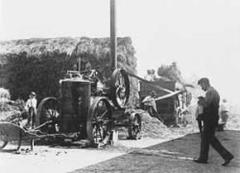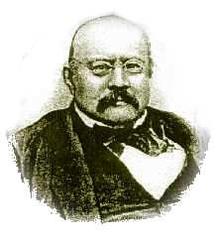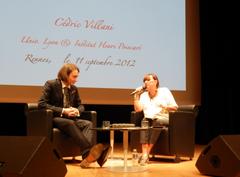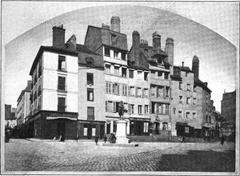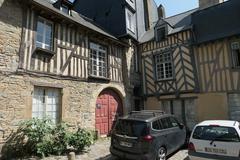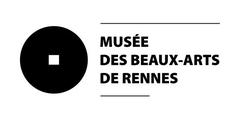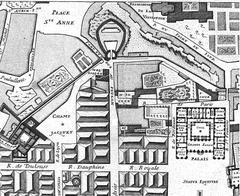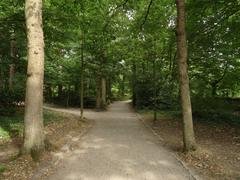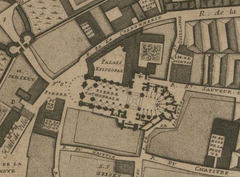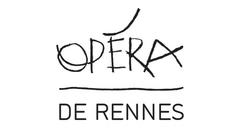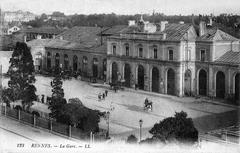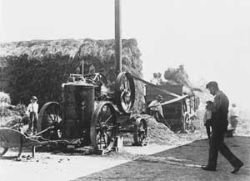
Visiting Écomusée du Pays de Rennes: Hours, Tickets, and Tips
Date: 24/07/2024
Introduction
The Écomusée du pays de Rennes is a captivating museum that immerses visitors in the rich historical and cultural tapestry of Rennes and its surrounding countryside. Nestled in the carefully restored ‘maison de retenue’ of the Grande Bintinais, this ecomuseum brings to life five centuries of local history, offering a unique perspective on the region’s agricultural and social evolution. Whether you are a history enthusiast, a cultural aficionado, or simply looking for an engaging day out, the Écomusée du pays de Rennes is an essential destination. This comprehensive guide aims to provide you with everything you need to know about visiting this remarkable museum, from its origins and exhibits to practical visitor information such as visiting hours, ticket prices, and accessibility options. By delving into the museum’s sections, you’ll gain a deeper understanding of the intertwined dynamics between urban and rural life, the significance of traditional agricultural practices, and the enduring cultural heritage that has shaped Rennes. Plan your visit to the Écomusée du pays de Rennes and embark on a journey through time that captures the essence of the region’s historical significance (Écomusée du pays de Rennes).
Table of Contents
- Introduction
- The Origins of La Bintinais
- Evolution of Urban and Rural Dynamics
- The Role of Agriculture and Rural Life
- Cultural and Traditional Insights
- Architectural Heritage
- Agricultural Practices and Innovations
- The Lives of Local Inhabitants
- The Prosperity of Rennes’ Countryside
- Practical Visitor Information
- Special Events and Demonstrations
- Conclusion
- FAQ
The Origins of La Bintinais
The Écomusée du pays de Rennes is housed in the meticulously restored ‘maison de retenue’ of the Grande Bintinais, a site that encapsulates five centuries of Rennes’ history and its surrounding countryside. The origins of La Bintinais date back to a time when Rennes was a city deeply intertwined with its rural surroundings. Until the early 20th century, Rennes was essentially a rural town, confined within its medieval walls and occupying only about 10% of the commune’s territory at the beginning of the 19th century (Écomusée du pays de Rennes).
Evolution of Urban and Rural Dynamics
The first section of the museum’s exhibition provides a comprehensive overview of the historical evolution of Rennes, supported by numerous maps and aerial photographs. This section illustrates the formation of suburbs along major access routes to the city center and the development of neighborhoods throughout the 20th century. Understanding these historical realities is crucial to grasping the strong city-countryside connection that has shaped the region (Écomusée du pays de Rennes).
The Role of Agriculture and Rural Life
The Écomusée delves into the agricultural practices and rural life that have been integral to the region’s history. The museum’s exhibits highlight the importance of agriculture in the Rennes area, showcasing the relationship between urban and rural communities. This relationship is exemplified by the practices of local farmers who, unable to purchase the most desirable farms, invested heavily in furniture. For instance, the price of armoires could vary significantly, reflecting the economic disparities within the rural community (Écomusée du pays de Rennes).
Cultural and Traditional Insights
The museum also explores the cultural and traditional aspects of the local community. The third section of the exhibition addresses various facets of local culture, influenced by the proximity to the city and its trends, as well as by wealthy farmers who sought to distinguish themselves from urban dwellers through their furniture. The renowned ‘double cintre’ armoires of the Rennes region were a symbol of this rural elite. The exhibition covers themes such as habitat, cuisine, costumes, ceremonies, and significant life events, providing a simple yet engaging way for new generations to understand enduring practices like the consumption of buckwheat galettes and the pruning of oak trees in the bocage (Écomusée du pays de Rennes).
Architectural Heritage
The fourth section of the museum is dedicated to the typical construction materials of the Rennes region, particularly earth construction. This method, which remains prevalent in many agricultural buildings today, is celebrated for its ecological benefits. Earth houses are cool in summer, warm in winter, and resource-efficient. However, their construction required significant labor, often provided by large farms or community solidarity. In the 1930s, it was not uncommon to see up to 50 people gathered to build a cellar (Écomusée du pays de Rennes).
Agricultural Practices and Innovations
The museum’s former barn is now dedicated to the agricultural practices and innovations that have shaped the region. This section emphasizes the ongoing relevance of the city-countryside relationship for the people of Rennes. It addresses contemporary concerns such as sourcing quality farm produce at reasonable prices and the importance of seasonal and locally sourced products. The exhibition also highlights the pressure from educated landowners who encouraged their tenants to innovate, leading to advancements in animal and plant breeding, the cultivation of fodder crops, and increased livestock productivity (Écomusée du pays de Rennes).
The Lives of Local Inhabitants
The upper floor of the ‘maison de retenue’ was historically reserved for the owners, a common practice around Rennes that underscores the relationship between urban and rural communities. Rent for the farm was paid partly in cash and partly in kind, including farm produce, firewood, and horse transport for owners who lacked stables in the city center. An immersive audiovisual presentation in this space allows visitors to explore four centuries of the site’s history, following the lives of owners, farmers, and laborers who lived there. This presentation also recreates the ambiance of the bourgeois apartment, a surprising feature above the farmers’ living quarters (Écomusée du pays de Rennes).
The Prosperity of Rennes’ Countryside
Contrary to the notion of earth as a ‘poor man’s material,’ the farmers of the Rennes basin were well aware of the fertility of their lands. This prosperity is reflected in the architecture, with massive barns, large stables, and peasant houses typically featuring two living rooms. These structures are testaments to the wealth of the Rennes countryside. Traditional construction techniques, continuously improved over time, began to disappear in the 1950s, replaced by post-war reconstruction methods and materials (Écomusée du pays de Rennes).
Practical Visitor Information
To make your visit more enjoyable, here are some important details:
- Visiting Hours - The museum is open from Tuesday to Sunday, 10 AM to 6 PM. It is closed on Mondays and public holidays.
- Tickets - General admission is €5 for adults, €3 for students and seniors, and free for children under 12. Special discounts are available for group bookings.
- Guided Tours - Guided tours are available upon reservation and provide an in-depth exploration of the museum’s exhibits.
- Travel Tips - The museum is easily accessible by public transport and offers ample parking for those traveling by car.
- Nearby Attractions - While in Rennes, consider visiting other historical sites such as the Rennes Cathedral and the Thabor Gardens.
- Accessibility - The museum is wheelchair accessible and provides facilities for visitors with disabilities.
Special Events and Demonstrations
Throughout the year, the Écomusée hosts various special events and demonstration days. These events offer visitors the opportunity to see traditional farming techniques in action, meet the museum’s mediators, and participate in hands-on activities. These events are particularly popular with families and provide a unique way to experience the museum’s offerings (Écomusée du pays de Rennes).
Conclusion
The Écomusée du pays de Rennes offers a rich and nuanced understanding of the historical and cultural significance of the region. By exploring various aspects of rural and urban life, visitors gain a deeper appreciation of Rennes’ enduring connection to its rural heritage. Plan your visit today and immerse yourself in the captivating history of Rennes.
FAQ
1. What are the Écomusée du pays de Rennes visiting hours?
- The museum is open from Tuesday to Sunday, 10 AM to 6 PM, and is closed on Mondays and public holidays.
2. How much are the Écomusée du pays de Rennes tickets?
- General admission is €5 for adults, €3 for students and seniors, and free for children under 12. Special discounts are available for group bookings.
3. Are guided tours available at the Écomusée du pays de Rennes?
- Yes, guided tours are available upon reservation and provide an in-depth exploration of the museum’s exhibits.
4. Is the Écomusée du pays de Rennes wheelchair accessible?
- Yes, the museum is wheelchair accessible and provides facilities for visitors with disabilities.
5. What are some nearby attractions to the Écomusée du pays de Rennes?
- Nearby attractions include the Rennes Cathedral and the Thabor Gardens.
For more updates and information, follow us on social media or download the Audiala mobile app (Écomusée du pays de Rennes).
